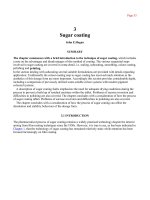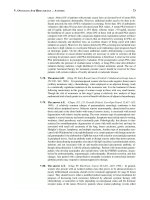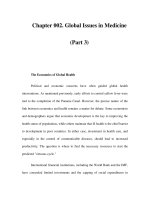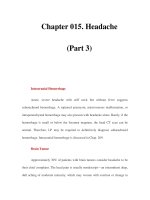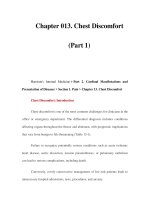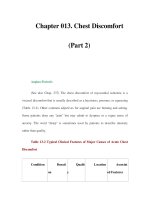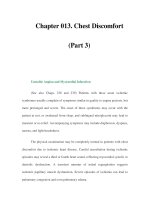Chapter 013. Chest Discomfort (Part 3) pdf
Bạn đang xem bản rút gọn của tài liệu. Xem và tải ngay bản đầy đủ của tài liệu tại đây (14.18 KB, 5 trang )
Chapter 013. Chest Discomfort
(Part 3)
Unstable Angina and Myocardial Infarction
(See also Chaps. 238 and 239) Patients with these acute ischemic
syndromes usually complain of symptoms similar in quality to angina pectoris, but
more prolonged and severe. The onset of these syndromes may occur with the
patient at rest, or awakened from sleep, and sublingual nitroglycerin may lead to
transient or no relief. Accompanying symptoms may include diaphoresis, dyspnea,
nausea, and light-headedness.
The physical examination may be completely normal in patients with chest
discomfort due to ischemic heart disease. Careful auscultation during ischemic
episodes may reveal a third or fourth heart sound, reflecting myocardial systolic or
diastolic dysfunction. A transient murmur of mitral regurgitation suggests
ischemic papillary muscle dysfunction. Severe episodes of ischemia can lead to
pulmonary congestion and even pulmonary edema.
Other Cardiac Causes
Myocardial ischemia caused by hypertrophic cardiomyopathy or aortic
stenosis leads to angina pectoris similar to that caused by coronary atherosclerosis.
In such cases, a loud systolic murmur or other findings usually suggest that
abnormalities other than coronary atherosclerosis may be contributing to the
patient's symptoms. Some patients with chest pain and normal coronary
angiograms have functional abnormalities of the coronary circulation, ranging
from coronary spasm visible on coronary angiography to abnormal vasodilator
responses and heightened vasoconstrictor responses. The term "cardiac syndrome
X" is used to describe patients with angina-like chest pain and ischemic-appearing
ST-segment depression during stress despite normal coronary arteriograms. Some
data indicate that many such patients have limited changes in coronary flow in
response to pacing stress or coronary vasodilators. Despite the possibility that
chest pain may be due to myocardial ischemia in such patients, their prognosis is
excellent.
Pericarditis
(See also Chap. 232) The pain in pericarditis is believed to be due to
inflammation of the adjacent parietal pleura, since most of the pericardium is
believed to be insensitive to pain. Thus, infectious pericarditis, which usually
involves adjoining pleural surfaces, tends to be associated with pain, while
conditions that cause only local inflammation (e.g., myocardial infarction or
uremia) and cardiac tamponade tend to result in mild or no chest pain.
The adjacent parietal pleura receives its sensory supply from several
sources, so the pain of pericarditis can be experienced in areas ranging from the
shoulder and neck to the abdomen and back. Most typically, the pain is
retrosternal and is aggravated by coughing, deep breaths, or changes in position—
all of which lead to movements of pleural surfaces. The pain is often worse in the
supine position and relieved by sitting upright and leaning forward. Less common
is a steady aching discomfort that mimics acute myocardial infarction.
Diseases of the Aorta
(See also Chap. 242) Aortic dissection is a potentially catastrophic
condition that is due to spread of a subintimal hematoma within the wall of the
aorta. The hematoma may begin with a tear in the intima of the aorta or with
rupture of the vasa vasorum within the aortic media. This syndrome can occur
with trauma to the aorta, including motor vehicle accidents or medical procedures
in which catheters or intraaortic balloon pumps damage the intima of the aorta.
Nontraumatic aortic dissections are rare in the absence of hypertension and/or
conditions associated with deterioration of the elastic or muscular components of
the media within the aorta's wall. Cystic medial degeneration is a feature of several
inherited connective tissue diseases, including Marfan and Ehlers-Danlos
syndromes. About half of all aortic dissections in women under 40 years of age
occur during pregnancy.
Almost all patients with acute dissections present with severe chest pain,
although some patients with chronic dissections are identified without associated
symptoms. Unlike the pain of ischemic heart disease, symptoms of aortic
dissection tend to reach peak severity immediately, often causing the patient to
collapse from its intensity. The classic teaching is that the adjectives used to
describe the pain reflect the process occurring within the wall of the aorta—
"ripping" and "tearing"—but more recent data suggest that the most common
presenting complaint is sudden onset of severe, sharp pain. The location often
correlates with the site and extent of the dissection. Thus, dissections that begin in
the ascending aorta and extend to the descending aorta tend to cause pain in the
front of the chest that extends into the back, between the shoulder blades.
Physical findings may also reflect extension of the aortic dissection that
compromises flow into arteries branching off the aorta. Thus, loss of a pulse in one
or both arms, cerebrovascular accident, or paraplegia can all be catastrophic
consequences of aortic dissection. Hematomas that extend proximally and
undermine the coronary arteries or aortic valve apparatus may lead to acute
myocardial infarction or acute aortic insufficiency. Rupture of the hematoma into
the pericardial space leads to pericardial tamponade.
Another abnormality of the aorta that can cause chest pain is a thoracic
aortic aneurysm. Aortic aneurysms are frequently asymptomatic but can cause
chest pain and other symptoms by compressing adjacent structures. This pain
tends to be steady, deep, and sometimes severe.
